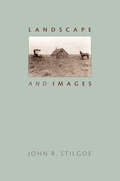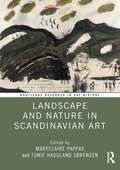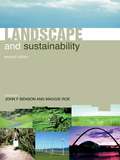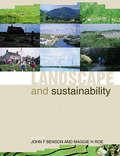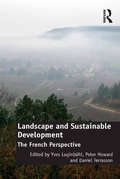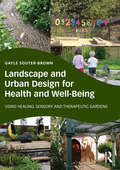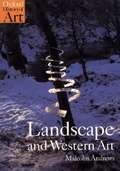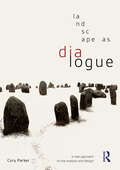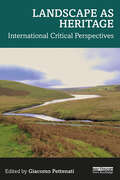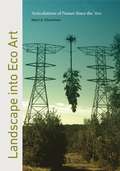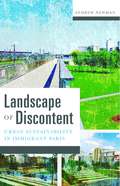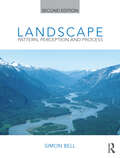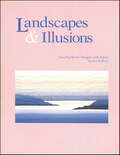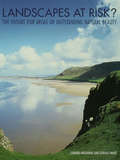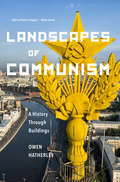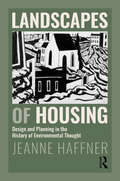- Table View
- List View
Landscape and Images
by John R. StilgoeJohn Stilgoe is just looking around. This is more difficult than it sounds, particularly in our mediated age, when advances in both theory and technology too often seek to replace the visual evidence before our own eyes rather than complement it. We are surrounded by landscapes charged with our past, and yet from our earliest schooldays we are instructed not to stare out the window. Someone who stops to look isn't only a rarity; he or she is suspect. Landscape and Images records a lifetime spent observing America's constructed landscapes. Stilgoe's essays follow the eclectic trains of thought that have resulted from his observation, from the postcard preference for sunsets over sunrises to the concept of "teen geography" to the unwillingness of Americans to walk up and down stairs. In Stilgoe's hands, the subject of jack o' lanterns becomes an occasion to explore centuries-old concepts of boundaries and trespassing, and to examine why this originally pagan symbol has persisted into our own age. Even something as mundane as putting the cat out before going to bed is traced back to fears of unwatched animals and an untended frontier fireplace. Stilgoe ponders the forgotten connections between politics and painted landscapes and asks why a country whose vast majority lives less than a hundred miles from a coast nonetheless looks to the rural Midwest for the classic image of itself.At times breathtaking in their erudition, the essays collected here are as meticulously researched as they are elegantly written. Stilgoe's observations speak to specialists--whether they be artists, historians, or environmental designers--as well as to the common reader. Our landscapes constitute a fascinating history of accident and intent. The proof, says Stilgoe, is all around us.
Landscape and Memory in Post-Fascist Italian Film: Cinema Year Zero (Routledge Advances in Film Studies)
by Giuliana MinghelliThis study argues that neorealism’s visual genius is inseparable from its almost invisible relation to the Fascist past: a connection inscribed in cinematic landscapes. While largely a silent narrative, neorealism’s complex visual processing of two decades of Fascism remains the greatest cultural production in the service of memorialization and comprehension for a nation that had neither a Nuremberg nor a formal process of reconciliation. Through her readings of canonical neorealist films, Minghelli unearths the memorial strata of the neorealist image and investigates the complex historical charge that invests this cinema. This book is both a formal analysis of the new conception of the cinematic image born from a crisis of memory, and a reflection on the relation between cinema and memory. Films discussed include Ossessione (1943) Paisà (1946), Ladri di biciclette (1948), and Cronaca di un amore (1950).
Landscape and Nature in Scandinavian Art (Routledge Research in Art History)
by MaryClaire PappasThis edited volume foregrounds new and vital scholarship shaping Scandinavian art historical research on the representations of the natural world.Contributors deconstruct the interlinking of people and land through critical readings of the Scandinavian representation of nature, bringing to the fore how the traditional focus on the landscape as a manifestation of temperament has tended to obfuscate critical approaches to the representation of the landscape. Making interdisciplinary connections, this volume redresses the imbalance in scholarship on the region that often emphasizes teleological national narratives and instead situates encounters with nature and the landscape in relationship to more interdisciplinary perspectives. Each chapter serves as a specific case study on topics ranging from circumpolar exploration and colonial practices, deconstructing National Romanticism myths, and contemporary artistic responses to the history of the politics of land.The book will be of interest to scholars working in art history, visual culture, nature studies, and environmental history.
Landscape and Sustainability
by Maggie Roe John F BensonThis unique book addresses the issue of sustainability from the point of view of landscape architecture, dealing with professional practices of planners, designers and landscape managers. This second edition contains updated and new material reflecting developments during the last five years and comprehensively addresses the relationship between landscape architecture and sustainability. Much in the text is underpinned by landscape ecology, in contrast to the idea of landscape as only appealing to the eye or aspiring cerebrally to be fine art. Landscape and Sustainability establishes that the sustainability agenda needs a new mindset among professionals: the driving question must always be ‘is it sustainable?’ Developing theory into practice, from the global to the local scale and from issues of policy and planning through to detailed design and implementation and on to long-term maintenance and management, the contributors raise and re-examine a complex array of research, policy and professional issues and agendas to contribute to the necessary ongoing debate about the future of both landscape and sustainability.
Landscape and Sustainability
by John F. Benson Maggie H. RoeThis unique book is about landscape, sustainability and the practices of the professions which plan, design and manage landscapes at many scales and in many locations; urban, suburban and rural. Despite the ubiquity of 'sustainability' as a concept, this is the first book to address the relationship between landscape architecture and sustainability in a comprehensive way.Much in the book is underpinned by landscape ecology, in contrast to the idea of landscape as only appealing to the eye or aspiring cerebrally to be fine art. As this book argues, landscape is and must be much more than this; landscape architecture is about making places which are biologically wholesome, socially just and spiritually rewarding.
Landscape and Sustainable Development: The French Perspective
by Peter Howard Yves LuginbühlPreviously published in French by Éditions Quae, this volume presents findings of a major research programme into landscape and sustainable development. While led by French scholars, the research team and geographical scope of the project was international, collaborative and comparative. Using case studies from across Europe, the interdisciplinary team of contributors discuss the relationship between landscape as defined by the European Landscape Convention and the concept of sustainable development. This English edition has a new introduction written by Yves Luginbühl and Peter Howard. The book is then divided into three sections: Biophysical Realities and Landscape Practice; Landscape Resources-Inheritance and Renewal; Governance and Participation. Some of the topics covered, such as wind-farm landscapes, will be familiar to English language readers, but others, such as footpath economics, non-woodland trees, inter-generational equity, and the insistence on the necessary developments in governance less so.
Landscape and Urban Design for Health and Well-Being: Using Healing, Sensory and Therapeutic Gardens
by Gayle Souter-BrownIn this book Gayle Souter-Brown explores the social, economic and environmental benefits of developing greenspace for health and well-being. She examines the evidence behind the positive effects of designed landscapes, and explains effective methods and approaches which can be put into practice by those seeking to reduce costs and add value through outdoor spaces. Using principles from sensory, therapeutic and healing gardens, Souter-Brown focuses on landscape’s ability to affect health, education and economic outcomes. Already valued within healthcare environments, these design guidelines for public and private spaces extend the benefits throughout our towns and cities. Covering design for school grounds to public parks, public housing to gardens for stressed executives, this richly illustrated text builds the case to justify inclusion of a designed outdoor area in project budgets. With case studies from the US, UK, Africa, Asia, Australasia and Europe, it is an international, inspirational and valuable tool for those interested in landscapes that provide real benefits to their users.
Landscape and Utopia (Routledge Research in Landscape and Environmental Design)
by Jody BeckThis book examines three landmark utopian visions central to 20th century landscape architectural, planning, and architectural theory. The period between the 1890s and the 1940s was a fertile time for utopian thinking. Significant geographic shifts of large populations; radically altered relations between capital and labor; rapid technological developments; large investments in transportation and energy infrastructure; and repetitive economic disruptions motivated many individuals to wholly reimagine society – including the connections between social relations and the built environment. Landscape and Utopia examines the role of landscapes in the political imaginations of the Garden City, the Radiant City, and Broadacre City. Each project uses landscapes to propose a reconstruction of the relationships between land, labor, and capital but - while the projects are well-known – the role played by landscapes has been largely left unexamined. Similarly, the radical anti-capitalism that underpinned each project has similarly been, for the most part, left out of contemporary discussions. This book sets these projects within a historical and philosophical context and opens a discussion on the role of landscapes in society today. This book will be a must-read for instructors, students, and researchers of the history and theory of landscape architecture, planning, and architecture as well as utopian studies, cultural and social history, and environmental theory.
Landscape and Western Art
by Malcolm AndrewsWhat is landscape? How does it differ from 'land'? Does landscape always imply something to be pictured, a scene? When and why did we begin to cherish images of nature? What is 'nature'? Is it everything that isn't art, or artefact? This book explores many fascinating issues raised by the great range of ideas and images of the natural world in Western art since the Renaissance. Using a thematic structure many issues are examined, for instance: landscape as a cultural construct; the relationship between landscape as accessory or backdrop and landscape as the chief subject; landscape as constituted by various practices of framing; the sublime and ideas of indeterminacy; landscape art as picturesque or as exploration of living processes. These issues are raised and explored in connection with Western cultural movements, and within a full international and historical context. Many forms of landscape art are included: painting, gardening, panorama, poetry, photography, and art. The book is designed to both take stock of recent interdisciplinary debates and act as a stimulus to rethinking our assumptions about landscape.
Landscape as Dialogue: A New Approach to Site Analysis and Design
by Cory ParkerLandscape as Dialogue redefines the process of understanding landscapes for students and practitioners so they can create more integrated, healthy places. Traditional site analysis sees the landscape as a series of components, evaluated individually, before being put back together. This perpetuates existing social hierarchies, maintains the need for high energy inputs and trumpets iconic designs that contribute to gentrification. This book examines the process of landscape dialogue as a natural give and take with the environment, drawing on diverse and challenging writings from design, geography, philosophy and ecological sciences to probe the relationship between humans and landscape. Each chapter begins with a discussion of a theoretical approach to landscape dialogue, such as perception, information or critique, before offering a series of practical steps and representation techniques that designers can use in understanding the landscape. Detailed illustrated case studies from around the world, including Hawaii, the American Southwest, Japan, China, Mexico, Turkey and Peru, explore the book’s lessons in practice. This must-read book offers a radical alternative to conventional analytical approaches, inspiring designers to fully engage in the landscape to ultimately generate ecologically considered places.
Landscape as Heritage: International Critical Perspectives
by Giacomo PettenatiThis edited book provides a broad collection of current critical reflections on heritage-making processes involving landscapes, positioning itself at the intersection of landscape and heritage studies. Featuring an international range of contributions from researchers, academics, activists, and professionals, the book aims to bridge the gap between research and practice and to nourish an interdisciplinary debate spanning the fields of geography, anthropology, landscape and heritage studies, planning, conservation, and ecology. It provokes critical enquiry about the challenges between heritage-making processes and global issues, such as sustainability, economic inequalities, social cohesion, and conflict, involving voices and perspectives from different regions of the world. Case studies in Italy, Portugal, Spain, Slovenia, the Netherlands, Turkey, the UK, Columbia, Brazil, New Zealand, and Afghanistan highlight different approaches, values, and models of governance. This interdisciplinary book will appeal to researchers, academics, practitioners, and every landscape citizen interested in heritage studies, cultural landscapes, conservation, geography, and planning.
Landscape as Infrastructure: A Base Primer
by Pierre BelangerAs ecology becomes the new engineering, the projection of landscape as infrastructure—the contemporary alignment of the disciplines of landscape architecture, civil engineering, and urban planning— has become pressing. Predominant challenges facing urban regions and territories today—including shifting climates, material flows, and population mobilities, are addressed and strategized here. Responding to the under-performance of master planning and over-exertion of technological systems at the end of twentieth century, this book argues for the strategic design of "infrastructural ecologies," describing a synthetic landscape of living, biophysical systems that operate as urban infrastructures to shape and direct the future of urban economies and cultures into the 21st century. Pierre Bélanger is Associate Professor of Landscape Architecture and Co-Director of the Master in Design Studies Program at Harvard University’s Graduate School of Design. As part of the Department of Landscape Architecture and the Advansed Studies Program, Bélanger teaches and coordinates graduate courses on the convergence of ecology, infrastructure and urbanism in the interrelated fields of design, planning and engineering. Dr. Bélanger is author of the 35th edition of the Pamphlet Architecture Series from Princeton Architectural Press, GOING LIVE: from States to Systems (pa35.net), co-editor with Jennifer Sigler of the 39th issue of Harvard Design Magazine, Wet Matter, and co-author of the forthcoming volume ECOLOGIES OF POWER: Mapping Military Geographies & Logistical Landscapes of the U.S. Department of Defense. As a landscape architect and urbanist, he is the recipient of the 2008 Canada Prix de Rome in Architecture and the Curator for the Canada Pavilion ad Canadian Exhibition, "EXTRACTION," at the 2016 Venice Architecture Biennale (extraction.ca).
Landscape for Living
by Garrett EckboThis seminal work essentially defined Modern landscape architecture. Eckbo saw landscape design as a vehicle for social change by breaking down the boundaries between indoor and outdoor living. Throughout Eckbo's career he maintained his vision of the interaction of art and science to create environments that were functional and livable, while maintaining the social, ecological and cultural approach to design.-Print ed.“One of the central figures in modern landscape architecture, Garrett Eckbo (1910-2000) was a major influence in the field during an active career spanning five decades. While most of the early American designers concentrated on the private garden and the corporate landscape, Eckbo's work demonstrated innovative design ideas in a social setting. This engagement with social improvement has stayed with Eckbo throughout his life, distinguishing both his intentions and achievements, from his early work for the Farm Security Administration to his partnerships (including one of the most prominent landscape firms in the world, Eckbo, Dean, Austin, and Williams—EDAW) and his years as chair of the Department of Landscape Architecture at the University of California, Berkeley.”-Marc Treib
Landscape into Eco Art: Articulations of Nature Since the ’60s
by Mark CheethamDedicated to an articulation of the earth from broadly ecological perspectives, eco art is a vibrant subset of contemporary art that addresses the widespread public concern with rapid climate change and related environmental issues. In Landscape into Eco Art, Mark Cheetham systematically examines connections and divergences between contemporary eco art, land art of the 1960s and 1970s, and the historical genre of landscape painting.Through eight thematic case studies that illuminate what eco art means in practice, reception, and history, Cheetham places the form in a longer and broader art-historical context. He considers a wide range of media—from painting, sculpture, and photography to artists’ films, video, sound work, animation, and installation—and analyzes the work of internationally prominent artists such as Olafur Eliasson, Nancy Holt, Mark Dion, and Robert Smithson. In doing so, Cheetham reveals eco art to be a dynamic extension of a long tradition of landscape depiction in the West that boldly enters into today’s debates on climate science, government policy, and our collective and individual responsibility to the planet.An ambitious intervention into eco-criticism and the environmental humanities, this volume provides original ways to understand the issues and practices of eco art in the Anthropocene. Art historians, humanities scholars, and lay readers interested in contemporary art and the environment will find Cheetham’s work valuable and invigorating.
Landscape into Eco Art: Articulations of Nature Since the ’60s
by Mark CheethamDedicated to an articulation of the earth from broadly ecological perspectives, eco art is a vibrant subset of contemporary art that addresses the widespread public concern with rapid climate change and related environmental issues. In Landscape into Eco Art, Mark Cheetham systematically examines connections and divergences between contemporary eco art, land art of the 1960s and 1970s, and the historical genre of landscape painting.Through eight thematic case studies that illuminate what eco art means in practice, reception, and history, Cheetham places the form in a longer and broader art-historical context. He considers a wide range of media—from painting, sculpture, and photography to artists’ films, video, sound work, animation, and installation—and analyzes the work of internationally prominent artists such as Olafur Eliasson, Nancy Holt, Mark Dion, and Robert Smithson. In doing so, Cheetham reveals eco art to be a dynamic extension of a long tradition of landscape depiction in the West that boldly enters into today’s debates on climate science, government policy, and our collective and individual responsibility to the planet.An ambitious intervention into eco-criticism and the environmental humanities, this volume provides original ways to understand the issues and practices of eco art in the Anthropocene. Art historians, humanities scholars, and lay readers interested in contemporary art and the environment will find Cheetham’s work valuable and invigorating.
Landscape of Discontent: Urban Sustainability in Immigrant Paris (A Quadrant Book)
by Andrew NewmanOn a rainy day in May 2007, the mayor of Paris inaugurated the Jardins d&’Éole, a park whose completion was hailed internationally as an exemplar of sustainable urbanism. The park was the result of a hard-fought, decadelong protest movement in a low-income Maghrebi and African immigrant district starved for infrastructure, but the Mayor&’s vision of urban sustainability was met with jeers. Drawing extensively from immersive, firsthand ethnographic research with northeast Paris residents, as well as an analysis of green architecture and urban design, Andrew Newman argues that environmental politics must be separated from the construct of urban sustainability, which has been appropriated by forces of redevelopment and gentrification in Paris and beyond. France&’s turbulent political environment also provides Newman with powerful new insights into the ways in which multiethnic coalitions can emerge⎯even amid overt racism and Islamophobia⎯in the struggle for more just cities and more inclusive societies. A tale of multidimensional political efforts, Landscape of Discontent cuts through the rhetoric of green cities to reveal the promise that environmentalism holds for urban communities anywhere.
Landscape: Pattern, Perception and Process
by Simon BellLandscapes develop and evolve through an interacting series of processes – climatic, geological, ecological and cultural – over varying periods of time. These processes shape the structure and character of the landscapes which we experience. Over time, distinctive patterns emerge – ranging in scale from the distribution of small plants to the sculptured sides of a huge canyon. Our perception of these patterns goes beyond just their visual appreciation – beautiful though they may be – into a richer understanding of how we experience our environment. By understanding this complex pattern–process interaction we can obtain a deeper awareness of landscape and our place in it – as inhabitants and as shapers. The book explores the nature of patterns and ways of classifying them before studying the nature of perception (primarily visual but including other senses), then proceeds to relate this perception to aesthetics and from there to the design process. From this point the main driving processes in landscape are introduced alongside the resulting patterns, these being climatic, landform, ecosystem and cultural aspects. It is this integrative approach of looking at landscape as a kind of self-organising system, overlaid by conscious human planning activities and the unity of pattern and process, which makes this book unique. Landscape draws from a wide range of neighbouring disciplines, of which the landscape planner or designer needs to be aware, but which are often taught as distinct elements. Bell binds these fundamentals together, which enables the landscape to be ‘read’, and this reading to be used as the basis for planning and design. This second edition updates and refreshes the original material with added sections and new photos, particularly making use of the developments in satellite photography. Featuring full colour throughout, this textbook is ideal for anyone studying landscape architecture or any of the disciplines which intersect with the landscape, and which affect it.
Landscapes & Illusions: Creating Scenic Imagery with Fabric
by Joen WolfromHere is the book to help you create strip-pieced fabric landscape quilts that reflect the ever-changing moods of nature. With clear, precise information on color and fabric, learn to create visual illusions of depth, luminosity, reflections, or mist that add drama and emotion to your scenic imagery.
Landscapes at Risk?: The Future for Areas of Outstanding Natural Beauty in England and Wales
by Edward Holdaway Gerald SmartAreas of Outstanding Natural Beauty (AONBs) together with National Parks are the highest quality landscapes in England and Wales, and have been designated to conserve that quality. AONBs have always been regarded as 'second' to national parks in terms of the legislation and resources provided by the nation to look after them. At the turn of the century they are at a cross-roads - there are many challenges to be overcome if they are to survive as the best. This book examines whether they are fit to meet the challenges and sets out a bold new Agenda for their survival.Landscapes at Risk? covers the history and development of AONBs in England and Wales set in the context of protected landscapes generally in the UK. It focuses on the evolution of policies towards them, the arrangements for their administration, conservation and management, the land management and planning context within which they have evolved, and the adequacy of the proposals that have been put forward for their long-term well-being. Throughout the analysis there are numerous references to the many initiatives that have been and are being taken by AONB managers and others to secure their future. The book features a series of case studies of individual AONBs to illustrate the main points being made in the text.
Landscapes between Then and Now: Recent Histories in Southern African Photography, Performance and Video Art (Photography, Place, Environment)
by Nicola BrandtIn Landscapes Between Then and Now, Nicola Brandt examines the increasingly compelling and diverse cross-disciplinary work of photographers and artists made during the transition from apartheid to post-apartheid and into the contemporary era. By examining specific artworks made in South Africa, Namibia and Angola, Brandt sheds light on established and emerging themes related to aftermath landscapes, embodied histories, (un)belonging, spirituality and memorialization. She shows how landscape and identity are mutually constituted, and profiles this process against the background of the legacy of the acutely racially divisive policies of the apartheid regime that are still reflected on the land. As a signpost throughout the book, Brandt draws on the work of the renowned South African photographer Santu Mofokeng and his critical thinking about landscape. Landscapes Between Then and Now explores how practitioners who engage with identity and their physical environment as a social product might reveal something about the complex and fractured nature of postcolonial and contemporary societies. Through diverse strategies and aesthetics, they comment on inherent structures and epistemologies of power whilst also expressing new and radical forms of self-determinism. Brandt asks why these cross-disciplinary works ranging from social documentary to experimental performance and embodied practices are critical now, and what important possibilities for social and political reflection and engagement they suggest.
Landscapes in Between
by Monica SegerSince its economic boom in the late 1950s, Italy has grappled with the environmental legacy of rapid industrial growth and haphazard urban planning. One notable effect is a preponderance of interstitial landscapes such as abandoned fields, polluted riverbanks, and makeshift urban gardens. Landscapes in Between analyses authors and filmmakers - Italo Calvino, Pier Paolo Pasolini, Gianni Celati, Simona Vinci, and the duo Daniele Ciprì and Franco Maresco - who turn to these spaces as productive models for coming to terms with the modified natural environment.Considering the ways in which sixty years' worth of Italian literary and cinematic representations engage in the ongoing dialogue between nature and culture, Monica Seger contributes to the transnational expansion of environmental humanities. Her book also introduces an ecocritical framework to Italian studies in English. Rejecting a stark dichotomy between human construction and unspoilt nature, Landscapes in Between will be of interest to all those studying the fraught relationship between humanity and environment.
Landscapes of Communism
by Owen HatherleyWhen communism took power in Eastern Europe it remade cities in its own image, transforming everyday life and creating sweeping boulevards and vast, epic housing estates in an emphatic declaration of a noncapitalist idea. The regimes that built them are now dead and long gone, but from Warsaw to Berlin, Moscow to postrevolutionary Kiev, the buildings remain, often populated by people whose lives were scattered by the collapse of communism.Landscapes of Communism is a journey of historical discovery, plunging us into the lost world of socialist architecture. Owen Hatherley, a brilliant, witty, young urban critic shows how power was wielded in these societies by tracing the sharp, sudden zigzags of official communist architectural style: the superstitious despotic rococo of high Stalinism, with its jingoistic memorials, palaces, and secret policemen's castles; East Germany's obsession with prefabricated concrete panels; and the metro systems of Moscow and Prague, a spectacular vindication of public space that went further than any avant-garde ever dared. Throughout his journeys across the former Soviet empire, Hatherley asks what, if anything, can be reclaimed from the ruins of Communism-what residue can inform our contemporary ideas of urban life?
Landscapes of Holocaust Postmemory (Routledge Research In Cultural And Media Studies #29)
by Brett Ashley KaplanHow do the spaces of the past stay with us through representations—whether literary or photographic? How has the Holocaust registered in our increasingly globally connected consciousness? What does it mean that this European event is often used as an interpretive or representational touchstone for genocides and traumas globally? In this interdisciplinary study, Kaplan asks and attempts to answer these questions by looking at historically and geographically diverse spaces, photographs, and texts concerned with the physical and/or mental landscape of the Holocaust and its transformations from the postwar period to the early twenty-first century. Examining the intersections of landscape, postmemory, and trauma, Kaplan's text offers a significant contribution to our understanding of the spatial, visual, and literary reach of the Holocaust.
Landscapes of Housing: Design and Planning in the History of Environmental Thought
by Jeanne HaffnerIn the twenty-first century, housing has become a site of ecological experimentation and environmental remediation. From the vantage point of contemporary architecture, conservation concerns and emergent building science technologies support one another, with new processes and materials deployed to reduce energy usage, water consumption, and carbon dioxide emissions. Landscapes of Housing examines this trend in historical perspective, arguing for a more considered environmental vision that includes the organic, social, and cultural dimensions of landscape. By shifting the focus from architecture, the book highlights and critiques the relationship between dwelling and landscape itself. Contributors from a wide range of international perspectives propose a more integrative ecology that includes history, culture, society, and materiality, in addition to technology, within contemporary ecological housing programs. This book will be a resource for upper-level students, academics, and researchers in landscape architecture interested in the social and political implications of ecological housing.
Landscapes of Leisure
by Sean Gammon Sam ElkingtonThe leisure landscape is a complex and diverse one that is both natural and built, dark and light, safe and dangerous, contained or without boundary, and profoundly influences the manner in which leisure is performed and experienced. These leisurescapes are increasingly becoming significant sites for the construction of individual and shared frameworks in which people orient themselves and act in wider society. Drawing on international contributions by leading researchers in the field, this collection aims to map out the complex relationship that leisure has with place. A key element of the volume will be to illustrate the transdisciplinarity of this key feature of leisure studies, and by doing so offer, for the first time, a more rounded and inclusive approach to the study of leisure and place. It also aims to explore and elucidate the extent to which leisure places and spaces form, affect and influence personal, social and collective identities.
